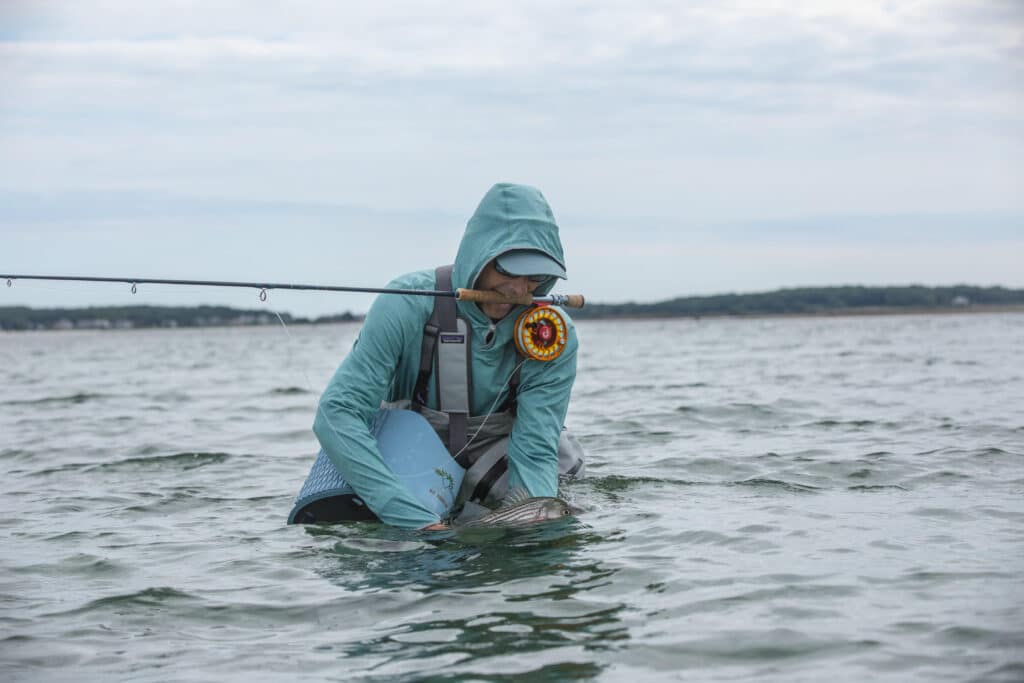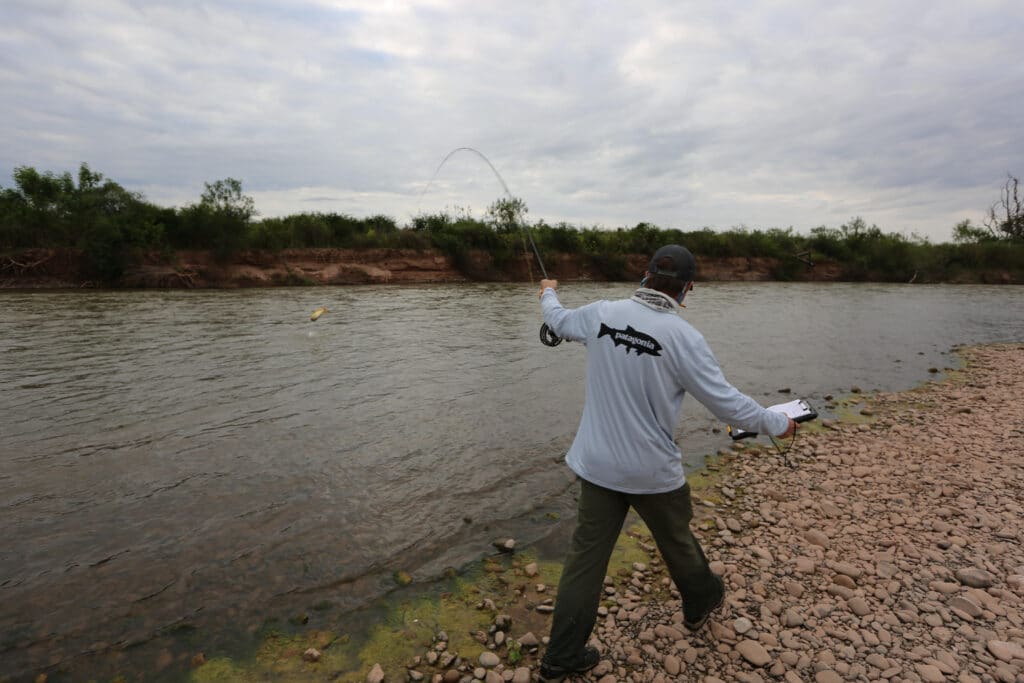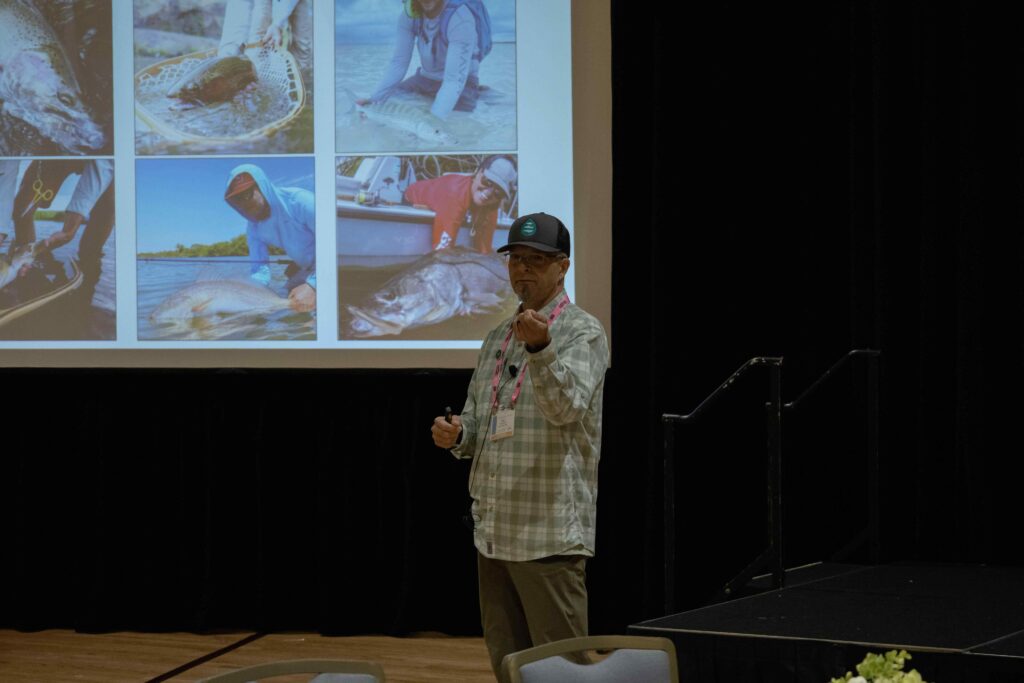
You’ve brought a nice fish to hand, and you want a photo to preserve the memory and brag on social media. How much time do you have to admire the fish before letting it go?
If you said, “10 seconds,” your information is correct. And the source of that information may well be Andy Danylchuk, Ph.D., one of the most prominent advocates for fish and their habitats in recent years. A self-described hardcore angler, Danylchuk is the science advisor to Keep Fish Wet, an organization dedicated to proper catch and release.
Danylchuk’s a busy scientist who, among other things, helped figured out where bonefish spawn while working with the Bonefish & Tarpon Trust in the 2000s. He’s also studied Atlantic tarpon, giant trevally in the Seychelles, golden dorado in South America, steelhead in the Pacific northwest, and sea-run brook trout in New England. He taught himself to fly fish and caught his first fish on a fly rod, a bonefish, on a fly he tied himself. He has had the good sense to live in the Turks and Caicos and the Bahamas, but today lives in Massachusetts, where he is a professor of fish conservation at UMass Amherst.
Danylchuk is on a “personal crusade” to get anglers to release their fish carefully and promptly to assure their survival after being returned to the water. He is also concerned with protecting aquatic ecosystems, having grown up near the Great Lakes at a time when each angler got “the equivalent of a small phone book” full of warnings about which pollutants were found in which fish.
“I loved fish and fishing so much, and I saw so many other people also loving to fish. They express how it has changed, and it keeps them out of trouble, like it did for me,” he said. “But I also saw the impacts of human activity on fish and aquatic environments.”
A Lifelong Angler

Born in Toronto, Canada, Danylchuk traces his fascination with the underwater world to a family trip to Andros, Bahamas, in 1973. “I remember walking along on the beach, and my dad putting a mask on my face and shoving me in the water, and what I saw was incredible,” he said. The experience “instilled in me an awe of nature and the aquatic environment.”
The first actual tug from a fish came a few years later, on a relative’s trout pond north of home, using a hand-me-down rod with the reel held on by rubber bands. “I was pretty naïve about how strong and powerful trout can be. I hooked a trout, and it just ripped the reel off the rod. That really started me on the path.” He hand-lined the fish. In his teens, he and his best friend, then and now, had chances to fish for bass and pike in lakes north of Toronto, and snook, redfish, and sea trout in Captiva Island, Florida.
Despite “good grades in bio and art and terrible grades in everything else,” Danylchuk was admitted to Trent University, where he turned in an honors thesis about marine fishes in Jamaica. Grad school took him back to Trent University for his masters and then to the University of Alberta in Edmonton, where he earned a doctorate and studied the impact of forestry on fish populations.
While in northern Alberta, where it was “cold and dark and nasty, remembering wonderful days when I was 5 with my head in the water in the Bahamas,” he learned of a position at The School for Field Studies in South Caicos, where he took up fly fishing after watching a friend catch a 7-pound bonefish in calf-deep water.
“I took my angler hat off and put my scientist hat on, and wondered, ‘How much do we really know about bonefish?’” he said. Only a few years later, he helped launch the Cape Eleuthera Institute in the Bahamas, and set to work studying bonefish reproduction and how they respond to being caught and released. Patagonia and Bonefish & Tarpon Trust contributed funding.
Danylchuk’s “geographical range expanded” in 2009 when he joined the faculty at UMass Amherst. “Everything I learned along the way in terms of science and education and outreach, I could apply now to many other places around the world,” he said.
The professor makes a point of translating what he and his students and collaborators learn into information anglers can use. Keep Fish Wet is the obvious example. Barbless hooks, rubber nets, awareness of water temperatures and spawning status, limiting lip grippers and boosting hook removers, and judicious picture-taking–all can make it more likely your fish survives and thrives. And with something like 47 billion fish caught worldwide (an old estimate) and more than half of them released, best practices can have a huge impact.
“What I see when I go fishing for striped bass is a large number of fish being caught and released, and a lot of those striped bass spending a lot of time on the bottom of the boat, being held up in the air for long periods of time, and being dragged across the gunnels. And if we really care about the future of striped bass, that’s got to change,” he said. “Each angler has the chance to practice conservation with each fish they release.”
(Striped bass is an especially good example. A post-covid surge in fishing, combined with the arrival of the huge 2015 class of stripers and ample bait, to create an astonishing catch rate in 2022. An emergency 28- to 31-inch slot limit was imposed in response, which means an awful lot of stripers are being released.)
A Skilled Communicator

Aaron Adams, executive director of Bonefish & Tarpon Trust, called working with Danylchuk “enjoyable and rewarding,” and credited him with influencing anglers to handle their fish with care.
“Andy is one of the rare colleagues who is not only a good scientist, but is good at communicating science in layman’s terms, which is an essential part of conservation science,” Adams said.
But while he has dedicated a big chunk of his career to promoting best C&R practices, Danylchuk doesn’t want to scold.
“Anglers don’t like to be told what to do,” he said. “They like to be shown, or they like to learn. As an angler I can understand that too: I don’t want be told what to do, I want to experience it myself. It’s a personal evolution as an angler to learn about these best practices.” If things go poorly with one fish, “What am I going to do differently for the next fish? Instead of taking a hard line, how about we work as partners and we’ll demonstrate the best ways fish can be handled and released?”









